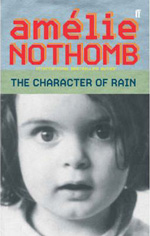
In the beginning was nothing, and this nothing had neither form nor substance—it was nothing other than what it was.
So begins this autobiographical novel of the author's first three years of life, which was originally published as Métaphysique des Tubes (The Metaphysics of Tubes) in 2000, and released in English translation with a far less apt title two years later.
The Nothombs, Belgian citizens who reside in Osaka, Japan in the late 1960s, give birth to their third child. From all appearances she appears to be a healthy girl. However, unlike her older siblings, she is only a Tube: she eats, digests and excretes, but doesn't move a muscle or interact in any meaningful way with her family or environment. Her parents call her "the Plant", as she requires no more care than a fern. She maintains this vegetative state until she turns two years of age, when suddenly and for no apparent reason she sits up and begins to scream. Her parents are initially overjoyed that "the Plant" has come to life, but are dismayed when she howls uncontrollably and unceasingly for the next six months. The spell is broken by her paternal grandmother during her visit from Belgium; she offers the child a stick of white chocolate, and Amélie comes to life as a sentient being, whose existence is validated by her first experience of pure pleasure.
Amélie likes her parents and older sister, who view her as a regular member of the family now that she is able to interact with them. However, the most important person in her life and the one she loves best is her first Japanese nanny Nishio-san, who treats Amélie as divine. In Japanese culture, each newborn is an okusama, or lord child, a status that is maintained until the child reaches school age. Not surprisingly, Amélie decides that she is Japanese, not Belgian, and preferentially spends her days with Nishio-san in the family's Japanese garden, which she views as her personal temple.
Despite this idyllic existence, her life is not a trouble free one. Several negative experiences lead Amélie to question who she is and what life is about, and to attempt to understand her surroundings and those closest to her. She painfully comes to realize, at the tender yet world weary age of three, that she is only a Tube after all; her life as an okusama will soon come to an end, as she must start school and will not be able to live in Japan with her beloved nanny forever. She is faced with a difficult choice: whether to accept her future as a Tube, or take action to permanently maintain her divine status.
The Character of Rain is a humor-filled, entertaining and witty story about a precocious young child who tries to make sense of her life and
environment within two often incongruent cultures. The metaphysical questions asked by the author throughout this short novel are thought provoking
without detracting from the narrative, and elevate this novel from a simple tale of childhood to a valuable and accessible narrative.

Faber and Faber, paperback, 9780571220496
